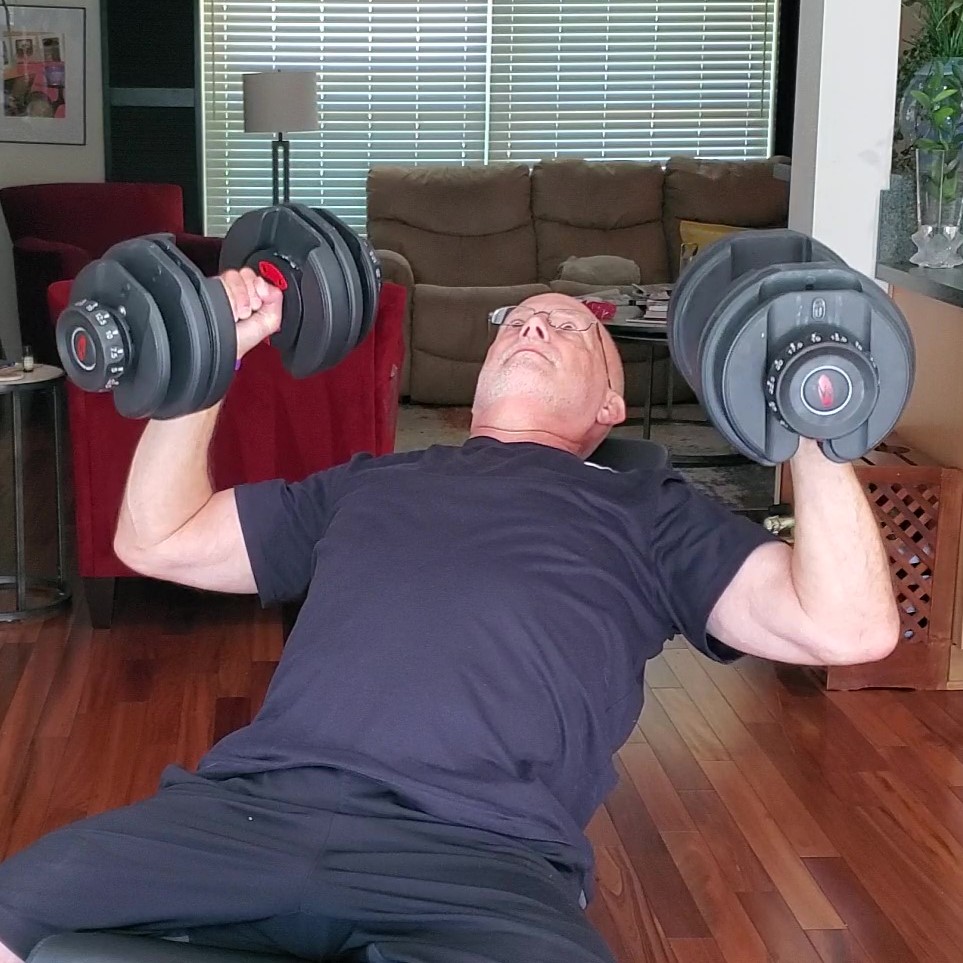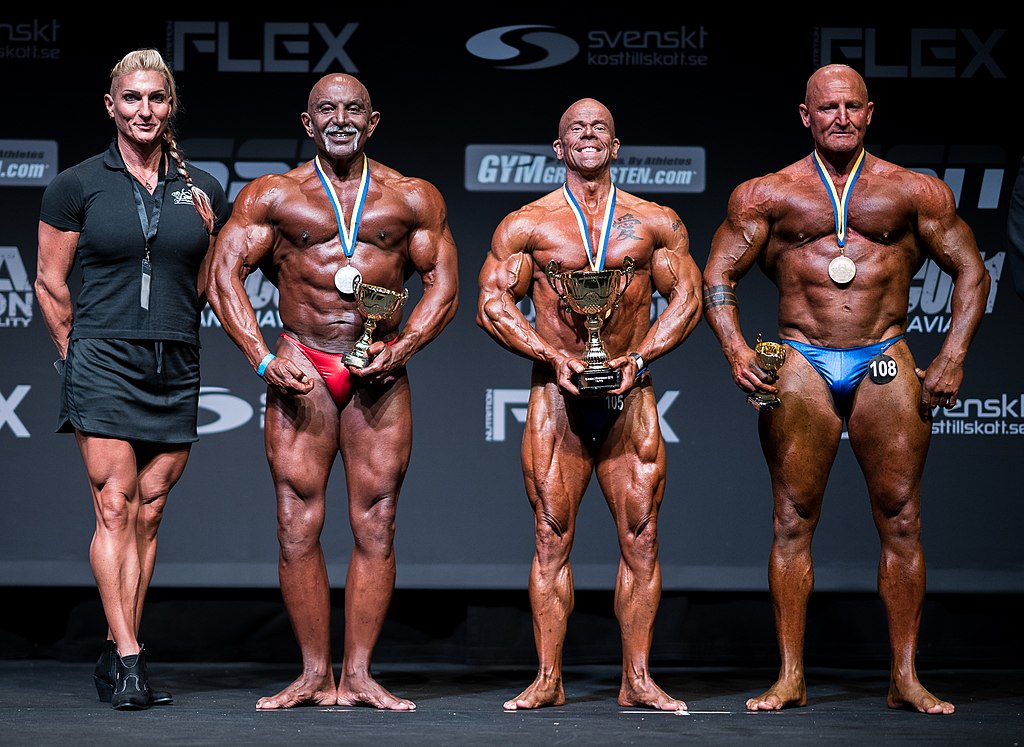Is it even possible to build muscle over 50?
Build muscle over 50? Isn’t it too late for that?
No, it’s not. Take heart – you really can.
But you need a slightly different approach than you used when you were in your 20’s.
And here’s why…..
Everybody repeat after me:
“Once I turned 50, everything started _ _ _ _ _ _ _ _ _ _ _ _.”
And of course, you said “falling apart”, or some variation of it.
Once you get over 50, you start feeling the effects of age-related wear and tear on your body. Things that used to be easy to do are getting harder.
Sarcopenia, or age-related muscle loss, causes a progressive decrease in strength and muscle mass, and to some extent happens to all of us.
Injuries from the past are coming back to haunt you. New injuries are much harder to recover from.
Hormone levels are dropping. Blood sugar levels are rising.
When you look in the mirror, things are a little different than they used to be. Abs are getting smoother. Arms are getting smaller.
And these problems threaten to diminish the quality of life in our later years, right at a time when we should be enjoying life the most.
It can all get very frustrating and discouraging.
The answer seems clear enough – the way you build muscle over 50 is to get on an effective strength training program. But a lot of people question whether or not that’s even possible at this age.
In this post, we’ll examine why it’s possible, and how you can build muscle and strength after 50, without getting hurt or wasting time.
Related Content on how to build muscle over 50:
-
Is Building Muscle After 50 Really Something You Can Realistically Achieve?
- 10 Home Gym Essentials On A Budget For Full Body Workouts To Get You Strong Really Fast
- The Ultimate Strength Training Program For Over 50 To Start Feeling Great Now
- Super Effective Workouts For Men Over 50 (That Won’t Take All Day To Do)
Build Muscle Over 50: Proven Strategies for Effective Strength Training
Building muscle after 50 is not only possible but also crucial for maintaining health and vitality as you age. You can counteract age-related muscle loss by incorporating specific training techniques and making essential lifestyle changes. Sarcopenia, or the natural decrease in muscle mass, begins around the age of 50. However, with the right approach, you can enhance your strength and muscle mass effectively.
Understanding the unique challenges and adjustments required to build muscle effectively after 50 can significantly impact your results. By focusing on resistance training, proper nutrition, and recovery, you’ll be well on your way to achieving your fitness goals. Prioritizing protein intake and considering supplementation can further support muscle growth and overall health.
Embracing these strategies will help you stay strong and active well into your later years, enhancing not just your physical capabilities but your quality of life. Whether you’re starting from scratch or enhancing your current routine, integrating these tips can lead to remarkable progress.
Key Takeaways
- Building lean muscle after 50 is achievable and vital for health.
- Resistance training and proper nutrition are key components.
- Lifestyle changes and recovery are essential for muscle growth.
Understanding Muscle Development After 50
Aging can impact your ability to build and maintain muscle mass. Key points include the effects of aging on muscle, strategies to overcome anabolic resistance, and methods to prevent sarcopenia.
The Science of Aging and Muscle
As you age, the natural decline in muscle mass and function becomes more pronounced. This is due to a combination of factors, including a decrease in anabolic hormones, like growth hormone and testosterone levels, and a reduction in the efficiency of muscle protein synthesis.
Structural changes in muscle fibers also occur, contributing to the overall loss of muscle strength and size. Understanding these changes is vital to developing effective strategies for combating muscle decline in your 50s and beyond.
Increases in muscular strength are an adaptive response to intense physical activity.
An adaptive response is a process your body activates to protect you from any stimulus it perceives as threatening.
For example, if you go outside on a hot, sunny summer day, the adaptive response is a suntan.
The process begins when your muscles are forced to do something they can’t easily do at their current level of strength, like lifting a heavy weight until you can’t lift it anymore. The body then adapts by getting stronger, so it will be better equipped to handle that weight in the future.
And just like getting a suntan, the physiological muscle building process doesn’t just suddenly stop working at 50, or any other certain age.
It works the same way whether you’re 20 or 65 – but the thing that changes is your ability to recover from intense strength training exercise.
The way we lifted weights with our buddies when we were 20 isn’t the best way for us now.
As you get older, the recovery process gets less efficient, and you need to adjust your strength training program to see continued results.
Overcoming Anabolic Resistance
Anabolic resistance is a reduced sensitivity to the muscle-building signals from proteins and anabolic hormones. To counter this, you should prioritize higher protein intake and perform resistance training, which has been shown to enhance the body’s ability to utilize dietary protein for muscle repair and growth.
Resistance training can help stimulate muscle protein synthesis and increase the production of anabolic hormones, aiding in overcoming this resistance. Consistency in training and nutrition is vital in effectively managing anabolic resistance.
Preventing Sarcopenia and Decline
Sarcopenia, the age-related loss of muscle mass and function, can significantly impact your quality of life. To prevent this decline, incorporating a mix of strength training, aerobic exercises, and proper nutrition is crucial. Aim for a balanced diet rich in high-quality proteins to support muscle maintenance and growth.
Regular physical activity helps maintain muscle strength and can slow the progression of sarcopenia. Addressing factors like Vitamin D deficiency and ensuring adequate caloric intake also play roles in preventing muscle decline. Efforts should be consistent and tailored to your specific needs to be most effective.
Essential Training Techniques

Master key strength training techniques to build muscle over 50. Focus on strength training fundamentals, proper form and balance, and the progressive overload principle for optimal results.
Strength Training Fundamentals
Resistance training should be a staple, and involves lifting weights or utilizing resistance bands to challenge your muscles.
To build muscle effectively, start with compound exercises. These target multiple muscle groups simultaneously, maximizing efficiency and effectiveness. Examples include leg press, wall squats, pulldowns, a rowing exercise, and bench press with dumbbells or a machine.
Consistency is critical. Aim for two sessions per week, giving muscles time to repair and grow. Keep your routine varied to prevent plateaus; mix up exercises and equipment regularly.
Importance of Proper Form
Using proper form is paramount to prevent injury and ensure you’re effectively targeting the intended muscles. When performing free weight exercises, keep your back straight and engage your core. This will help improve overall strength and reduce the risk of falls and injuries.
Progressive Overload Principle
Progressive overload is the gradual increase of stress placed on your muscles during training. To apply this principle, consistently increase the weights you lift, the number of reps, or the intensity.
Keep a log of your workouts to track progress and ensure you’re continually challenging your body. This approach promotes muscle growth and adaptation, which is essential for building muscle over 50.
Nutrition and Supplementation Strategies
Proper nutrition and thoughtful supplementation are essential to building muscle over 50. Focus on optimizing protein intake and incorporating essential nutrients into your diet.
Optimizing Protein Intake
Protein comes from the Greek word proteios, meaning “primary” or “holding the first place.” Protein is crucial for building lean muscle, and repair and maintenance of many tissues in the body. Including adequate amounts of protein in every meal should be your first consideration to support your strength building efforts.
So how much protein does a 50 year old man or woman need to build muscle?
Recent research indicates that protein needs for older adults who engage in strength training are higher than previously thought – about 1.6 grams of protein per kilogram (2.2 pounds) of body weight per day. (Pubmed)
For example, I weigh 170 pounds, so to determine my daily protein intake needs I would convert my weight to kilograms (170 divided by 2.2), which is 77.27 kg, and multiply that by 1.6, which equals 123.62, which I round up to 124 grams of protein needed per day.
Sources include lean meats, eggs, dairy, legumes, and fish. A high-protein diet promotes muscle synthesis and aids recovery post-exercise.
Post-workout nutrition
For the first 30 to 60 minutes immediately following an intense workout, there is a window of time where your muscles are more receptive to energy replenishment and rebuilding. The way to take advantage of this situation is to consume a high protein, carbohydrate-rich snack within the first hour after your strength training workout. Many experts believe that about 20 grams of protein in this snack is optimal for hastening the recovery and rebuilding process.
There are many nutrition shakes and bars on the market with 20+ grams of protein that can offer a convenient way to get your post-workout snack. You could also try 8 ounces of low-fat milk, chocolate milk or yogurt; a sandwich with low-fat protein sources like chicken or turkey; or a protein shake made with whey protein powder.
Incorporating supplements like protein powders, particularly whey protein, are convenient options to boost intake. Older adults should space protein consumption evenly throughout the day, with each meal containing around 20-30 grams of protein.
Incorporating Essential Nutrients
Vitamins and minerals are vital for maintaining muscle health. Ensure sufficient intake of vitamin D and omega-3 fatty acids. Vitamin D, found in fortified dairy products and sunlight exposure, supports bone health and muscle function. Omega-3s, present in fatty fish like salmon and chia seeds, reduce inflammation and support muscle maintenance.
Pay attention to carbohydrates, which provide the energy required for effective workouts. Include complex carbs like whole grains and vegetables for sustained energy release. Healthy fats from nuts, avocados, and olive oil are also essential for overall health and hormone production.
Incorporating a variety of nutrient-dense foods helps ensure that all necessary vitamins and minerals are covered, promoting not only muscle health but also overall well-being. Consider a balanced diet rich in red meat, legumes, and dairy products to cover the essential nutritional spectrum.
Lifestyle Factors Affecting Muscle Growth
A healthy lifestyle is crucial for muscle growth, particularly for those over 50. Key factors include proper rest, recovery, and effective stress management. These elements help enhance muscle performance and overall well-being.
Importance of Rest and Recovery
Rest and recovery are essential aspects of muscle growth. Quality sleep allows your body to repair tissues and synthesize proteins, which are vital for muscle building. Aim for 7-9 hours of sleep per night to optimize muscle recovery and performance.
During rest periods, you should also focus on hydration. Proper hydration helps maintain muscle function and reduces the risk of cramps and injuries. Drink plenty of water throughout the day, especially before and after workouts.
In addition to sleep and hydration, incorporating flexibility and mobility exercises can improve muscle functionality. Gentle stretching or yoga can enhance blood flow, reduce muscle stiffness, and promote better recovery.
Managing Stress for Better Outcomes
Stress management is another critical factor in muscle growth. Chronic stress increases cortisol levels, a hormone that can break down muscle tissues and hinder muscle repair. Implement stress-reducing practices such as meditation, deep breathing exercises, or engaging in hobbies you enjoy.
Mental health is linked to physical performance. A positive mental state can improve your motivation and consistency in following a training regimen. Regularly practicing mindfulness or gratitude can boost your mental well-being and, consequently, your physical health.
Managing stress also involves maintaining a balanced diet rich in nutrients that support muscle health. Consuming adequate protein, vitamins, and minerals helps combat the negative effects of stress and keeps your muscles strong and healthy.
The newfound popularity of bodybuilding after 50 – gain muscle mass to improve health and performance

If you’re thinking about bodybuilding, now may be a perfect time.
As you age, you lose lean muscle mass. You may have less energy and be less active. Bodybuilding can reverse the process, helping you build muscle mass and have more energy. (Webmd.com)
And many people over 50 who start weight training for the health benefits soon develop an interest in competitive bodybuilding.
An Over-50 category was added to the NPC Southern States Bodybuilding Championships, held annually in South Florida, in 2013.
“Older people take pride in their own physique, especially when they want to look hot in South Florida. They can still be strong, and look good, and feel better, and that’s what keeps them motivated”, said Peter Potter, organizer of the event.
Frequently Asked Questions
Understanding how to build muscle over 50 involves several specific considerations, including dietary strategies, training frequency, supplements, and hormonal changes.
What foods build muscle after 50?
You should focus on consuming a balanced diet rich in protein, healthy fats, and whole foods. Protein sources like lean meats, fish, eggs, and dairy products are essential. Including calcium and vitamin D-rich foods can also help maintain bone health, which supports muscle function. These are effective dietary strategies for muscle growth in individuals over 50.
How does resistance training frequency affect muscle development in those aged 50 and older?
Optimal muscle growth typically occurs with resistance training sessions 2 times per week. This frequency allows sufficient recovery time while still providing consistent stimulus for muscle hypertrophy. Incorporating a mix of compound and isolation exercises can help target all major muscle groups effectively.
What supplements should a 50 year old man take to build muscle?
There are specific supplements recommended for men and women over 50 to aid in muscle building. Creatine, whey protein, and omega-3 fatty acids are frequently recommended to support muscle growth. Creatine can improve strength and performance, while whey protein can help meet the increased protein requirements. Omega-3 fatty acids can reduce inflammation and support overall muscle health.
How can women over 50 optimize muscle gain post-menopause?
Women can benefit from resistance training, ensuring adequate protein intake, and possibly increasing calcium and vitamin D to support bone density. Tailoring workouts to include weight-bearing exercises can help counteract the effects of reduced estrogen levels, which can impact muscle mass and strength.
What role does hormone replacement therapy play in muscle development after 50?
Hormone replacement therapy (HRT) can help mitigate the decrease in muscle mass associated with aging, particularly in post-menopausal women. HRT may improve muscle strength and decrease fat mass, but it should be considered on an individual basis and discussed with a healthcare provider to weigh the benefits and risks.
What are the differences in muscle building strategies between individuals over 50 and those younger?
Individuals over 50 may need longer recovery times and lower training volumes compared to younger individuals. Prioritizing form and avoiding heavy loads that risk injury are crucial. It’s also important to incorporate flexibility and mobility exercises to prevent stiffness and enhance movement quality.
To recap:
You can build muscle over 50, but you’ll need to make some age-related modifications to your workout program to maximize your results.
Once you get over 50, your ability to recover from intense muscle building workouts decreases. To compensate for this, cut your strength training workouts down to 45 minutes or less, once or twice a week, but be sure to put in a maximum effort on every workout.
To work around chronic aches and pains, be careful not to over-stretch your joints when weight training; work only in a pain-free range of motion.
To avoid needless injuries, always move the weights slowly and deliberately – don’t throw them, and don’t drop them.
You get what you train for. Maintaining muscle mass requires brief, intense workouts using heavy weights.
A high-protein snack right after your workout can enhance recovery and muscle growth.
Many people over 50 are finding that bodybuilding workouts are a great way to combat health issues and improve your overall fitness level.
Incorporate these ideas into your strength training program, and there’s no reason you can’t continue to build muscle over 50.

